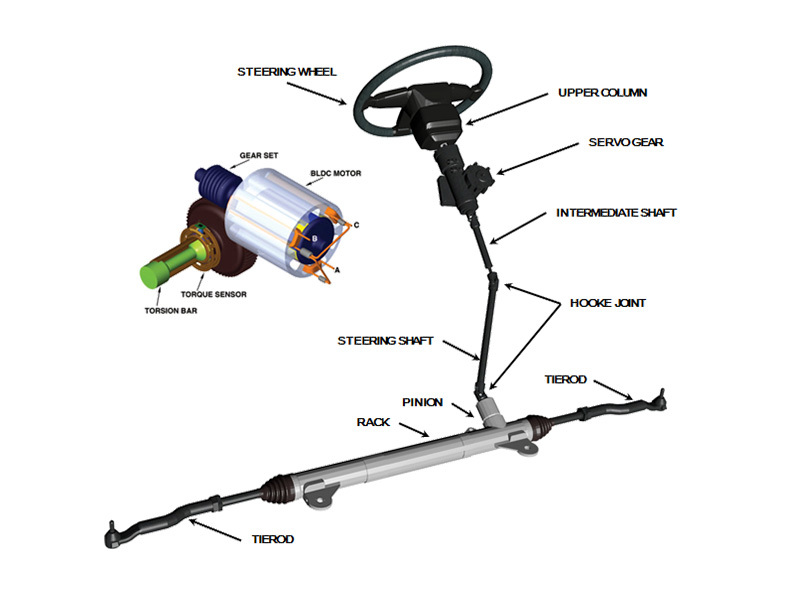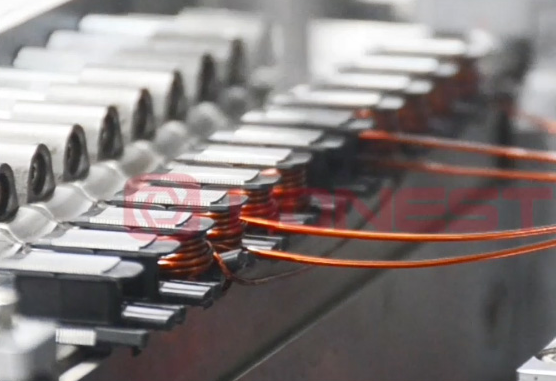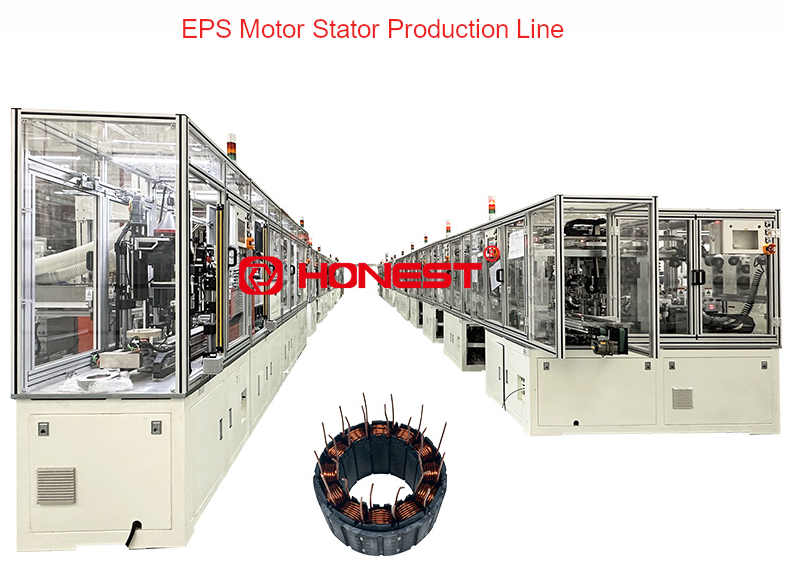
News Center
Electric Power Steering Motor Stator Automated Assembly Line
Published on.
2024-07-29 16:56
Source
Electric Power Steering (EPS) Motor, a core component of automotive systems, significantly impacts the stability, comfort, and safety of vehicle operation. During driving, the driver maneuvers the steering wheel, through a transmission mechanism, causing the steering wheels to deflect on the road surface, altering the vehicle’s direction of travel and ensuring stable and safe driving. The stator of the EPS motor not only affects the motor’s performance but is also directly related to the overall system’s stability and reliability.
Main Components of the EPS Motor Stator
Stator Core: Typically made from laminated silicon steel sheets, its primary function is to generate a magnetic field. By passing current through the stator winding, a magnetic field is created, which interacts with the rotor to produce torque and drive the motor’s rotation.
Stator Winding: Wound within the slots of the stator core, it generates a magnetic field through current, interacting with the rotor’s magnetic field to produce electromagnetic force, thereby driving the rotor’s rotation.
Stator Support Structure: Includes brackets and bearing housings, used to fix the stator and support the mechanical parts of the motor.

HONEST Intelligent’s EPS Motor Stator Automated Assembly Line
The production line is arranged in a straight line, with materials smoothly conveyed through a shuttle board and conveyor system. It employs an advanced industrial control data acquisition system to ensure traceability of the production process and highly integrates various process methods to achieve error-proofing and anti-idling, the details are as follows:
Vision Inspection: It ensures correct placement and identification of materials.
Material Reversal Detection: It automatically recognizes and adjusts the direction of materials to prevent errors.
Missing Parts Detection: It monitors each step of the assembly process to ensure nothing is omitted.
Pressure Monitoring: Real-time monitoring of the pressure during the assembly process to ensure quality.
Welding Inspection: It ensures the quality and consistency of the welding process.
Introduction to Key Process Equipment
Core Splitting Machine
The robotic arm, guided by a vision system, accurately picks up the core to the pre-pressing station, where the servo press automatically performs the pressing operation. The transfer module then moves the pre-pressed core to the inspection station to check the core height and orientation, before sequentially transferring it to the coding and splitting stations to complete the coding and splitting operations.
Terminal Board Inserting Machine
The upper and lower terminal boards are automatically fed through a vibration bowl, and the handling module accurately picks up the boards for pressing and flipping. The boards are automatically discharged to the pressing mold, where the cylinder extends to support the boards, and the module automatically presses the core into the terminal board. Sensors monitor the pressing process in real time to ensure the terminal board is properly pressed. After pressing, the handling module returns the core to the shuttle board and continues to feed the core to the coding station in the specified order, flipping it, and printing a QR code on the core with the marketing machine. Subsequently, the reader reads and confirms the quality of the QR code, ensuring the accuracy and traceability of the information.
Winding Machine
Firstly, the stator core assembly is automatically fed to the winding machine’s positioning seat. Once the sensor detects that the stator core is in place, the winding machine automatically threads the wire onto the wire rack and starts winding. A servo tensioner controls the winding tension to ensure uniform and compact coils. The tension monitoring system feeds back OK/NG signals to the PLC control system, monitoring the winding quality in real time. The diamond-tipped stripping knife strips the paint at the specified position of the wire head, with the stripping length adjustable according to production needs. The innovative design not only improves stripping accuracy but also reduces material waste.

Laser Welding Machine
After forming a circle, the stator assembly is automatically picked up and fed, and the reader binds the core QR code. The servo press automatically tightens the core, and the core is pressed into the transfer ring gauge, which is then transported to the welding turntable pressing station. The pressing station is equipped with two sets of presses to ensure the core’s reference surface is level.
After the core rotates to the welding station, the laser welding machine automatically locates the welding seam position for precise laser welding. A smoke processor is equipped to collect dust and ensure the welding quality and cleanliness of the production environment.
After welding, the assembly will pass through an inspection station, where the stator’s internal diameter is checked with an internal diameter gauge, and the welding seam position and length are checked with vision photography. A light curtain checks the height and roundness of the stator. These inspection mechanisms ensure welding quality. After inspection, the assembly is cooled by blowing air and transferred to the next machine.
Stator Hot Fitting & Cooling Machine
In this process, the handling module automatically transports the housing to the high-frequency heating station, where a temperature sensor monitors the heating temperature to ensure consistency in the heating process. The module then transports the stator to the upper mold for secondary positioning, and after heating, it flows into the lower mold for pressing. The servo press automatically presses the stator core into the housing, monitoring the pressure displacement during the process, and after pressing, further enhances the traceability of product information.
After pressing, the stator assembly undergoes rapid cooling and is fed to the cooling station, where it is cooled to near room temperature through circulating air cooling. After cooling, the product that passes the checks for pressing angle, depth, and stator core internal diameter is transferred to the next machine.
Advantages of HONEST Intelligent Production Line
1.Achieves traceability of the production process, highly integration process methods such as vision inspection, material reversal detection, missing parts detection, pressure monitoring, and welding inspection, to achieve error-proofing and anti-idling effects.
2.High level of automation, with many processes automatically completed by equipment, saving labor costs.
3.Multiple process sections are equipped with defective equipment alarm prompts, and defective products are automatically directed to the defective product area without interrupting the production process.

The above equipment is part of the process sections used in this production line. If you are interested in other process section equipment or require customized non-standard solutions, please feel free to contact us. We will provide you with detailed introductions and look forward to receiving your message.
Related News






